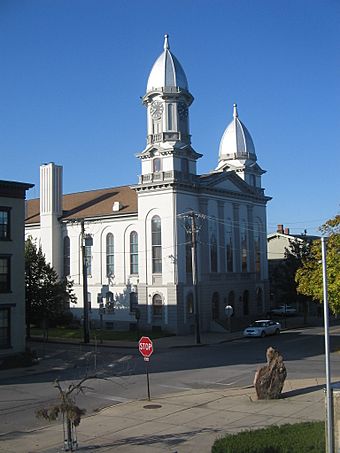Water Street District facts for kids
Quick facts for kids |
|
|
Water Street District
|
|

Clinton County Courthouse, an example of Italian Villa style architecture found in the district
|
|
| Location | Near the West Branch Susquehanna River in downtown Lock Haven, Pennsylvania |
|---|---|
| Built | Mid- to late 19th century |
| NRHP reference No. | 73001618 |
| Added to NRHP | July 10, 1973 |
The Water Street District is a special historical area in downtown Lock Haven, Pennsylvania. This city is located in the U.S. state of Pennsylvania. In 1973, this district was added to the National Register of Historic Places (NRHP).
The district includes Lock Haven's main business area. It also has many old homes and churches. These buildings were built in the 1800s, especially during the Victorian era. In 1973, experts found over 365 historic buildings here. Many of these buildings show the wealth created by the lumber industry long ago.
Contents
Exploring the Water Street District's History
The Water Street District is like a living museum. It shows how people lived and worked in the 1800s. Many buildings here have unique architectural styles. These styles were popular during the time they were built.
Famous Buildings in the District
The district has many important old buildings. Here are a few examples:
- The L.A. Mackey House (built 1854) mixes Federal and Tuscan styles.
- The David Carskaddon Homestead (built 1858) is in the Italian Villa style.
- The James White House (built 1856) combines Greek Revival and Tuscan styles.
- The Winslow-Crawford House (built 1855) is a unique Steamboat Gothic style home.
- The Craig-Furst House (built 1860) shows the Gothic Revival style.
- The Clinton County Courthouse (built 1867) is also in the Italian Villa style.
- The Jacob Graftius House (built 1857) has a Federal-Tuscan look.
- The W.A. Simpson House (built between 1872 and 1880) is a three-story brick home. Its wood looks like carved stone.
The district also includes other important historic buildings. You can find the old canal lock that gave Lock Haven its name. The site of Fort Reed is also here. This fort was one of the last early forts along the West Branch Susquehanna River.
Where is the Water Street District?
The Water Street District is easy to find. It is bordered by the West Branch Susquehanna River to the north. North Henderson Street is on the east side. Bellefonte Avenue, Mary's Alley, and the old Penn Central Railroad tracks are to the south. Sixth Street forms the western border.
What is the National Register of Historic Places?
The National Register of Historic Places (NRHP) is an official list. It includes properties in the U.S. that are important for their architecture, history, culture, or engineering. When a place is listed on the NRHP, it gets special recognition.
Benefits of Being on the NRHP
Being on the NRHP helps protect these important places. It can make them eligible for federal planning for historic preservation. Sometimes, it can also help them get funding or tax relief. This helps keep these historic buildings safe for future generations to enjoy.



